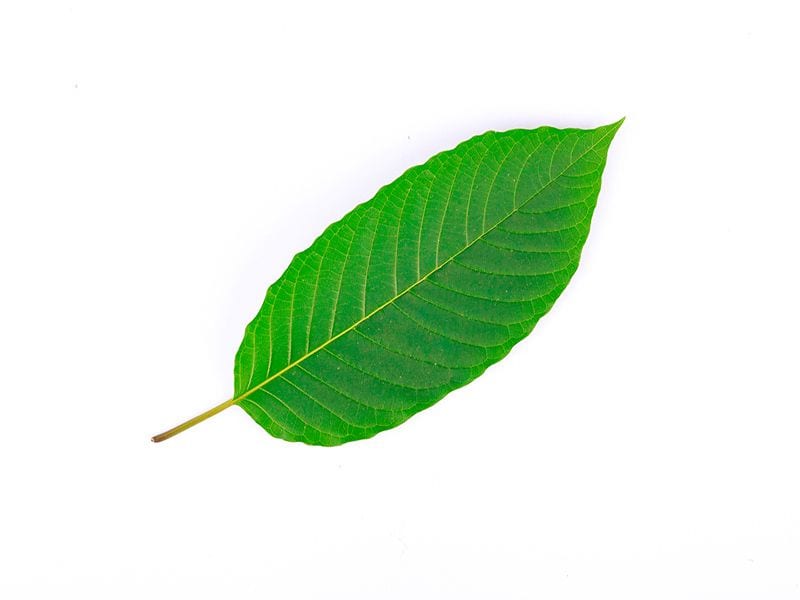|
Mitragyna speciosa, better known as "kratom" is a species of tree that originates from Indonesia and is related to the coffee plant. Its leaves have been used for countless years for its medicinal properties, mostly in conjunction with energy and feelings of wellbeing.
The most common consumption of kratom is as a tea or in a capsule. Its dried, ground and sold as a greenish powder. Kratom generally comes in three strains, based on the vein coloring of the leaf: green, red, and white. The average dosage of kratom is about a teaspoon at a time, but each person needs to find their "sweet spot" dose. Unlike most drugs or supplements, more isn't better with kratom: too much and you're in for a nasty bellyache. Its actually better to be frugal. Different strains of kratom have different effects on the mind/body, and are often broken down into three categories: slow, medium, and fast. "Slow" strains tend to have a calming effect. "Medium" tends to lower anxiety and increases non-physical productivity, and "fast" tends to improve physical productivity output. There's a massive controversy about kratom right now; ironically, although not a narcotic, it "tricks" the brain into thinking its receiving a narcotic substance. This has made it a cost-effective, natural way to detox off narcotics for addicts and while this seems like a miracle solution to the opioid crisis, its not being championed. Theories abound about the possibility that much like cannabis, kratom is not something a pharmaceutical company can profit from nor control, and because the average "kick" time using kratom for an addict is about 7 days, recovery treatment centers aren't exactly championing it either. 7 days of kratom costs a user about $32, give or take. Additionally, its not an addictive substance, although if used regularly, one can build up a tolerance to a strain and the effects are slightly diminished. This is often remedied by switching around to different strains in round-robin fashion, or just simply stop using it for a little while. Some folks use it to help with chronic pain, and that's where I come in. Its not a painkiller; its a supplement to help manage pain. I found that certain slow strains (for me, the white variety) will tamp down the intensity of pain, particularly neuralgia. Kratom comes on slowly; in fact, you kind of don't realize you're feeling the effects at first. Unlike THC in cannabis (which I have tried for pain management and migraine), its psychotropic effects are not mind-altering, and I don't feel sleepy like a narcotic would make you feel. Its very much like coffee or black tea, or a very mild sedative, in its effects. I often feel very upbeat after about 20 minutes of drinking the tea, and for the pain, its still there but doesn't seem to bother me as much. If there was tension or anxiety in my body, kratom helps lower it a bit. Additionally, slow and medium strains of kratom give me a little burst of energy, the type that allows me to complete a task or focus on something for a few hours. Unlike coffee, I don't feel a comedown quite the same way; its slower and more natural to the rhythm of how your body will slow down or tire. I don't experience a "crash". Because of my Addison's Disease, energy management on a daily level is monitored and often frugal, since I don't have cortisol or aldosterone production and have to fully rely on steroids to get me through the rigors of the day. Kratom doesn't seem to interfere with this, nor does it seem to sap out or stress my system the way that caffeine can. I only drink one or two small cups of kratom tea a day (one in the morning, one in mid afternoon), which is about a teaspoon of the powder in each cup, and that's all I really need. Some people are fine with just one dose a day, or even every other day. I like the little bursts of energy, otherwise I often don't even need it daily, just when my neuralgia is acting up. Honestly, its kind of a chill supplement in comparison to its robust cousin, the coffee bean. I do have to take narcotics to manage pain, especially if its really bad, and kratom helps reduce the need to take them. I really like that. Kratom is my first go-to for the nerve pain, and often is enough (combined with rest and other things to help get the nerves to calm down). Like any substance, one needs to educate themselves on it, its effects, how to ingest it, and of course, find reputable places to get them (I really trust the website "Happy Hippo" and their products have been really good). I have noticed doctors freak out about kratom, mostly because they know so little about it, but I do think its important to discuss it with your doctor if you want to use it as a supplement, and I don't know how it affects children under 18. However, for myself, I've been pleasantly surprised with kratom and its relative safety thus far. I don't think its fair to demonize this tree leaf, or to fear it; its really worth learning more about.
0 Comments
Your comment will be posted after it is approved.
Leave a Reply. |
AuthorJulie Baroh is a US artist, entrepreneur, and chronic chatterbox. Categories
All
Archives |

 RSS Feed
RSS Feed
